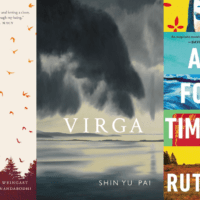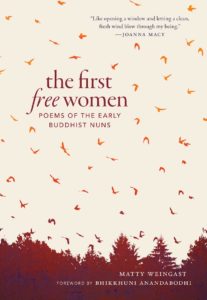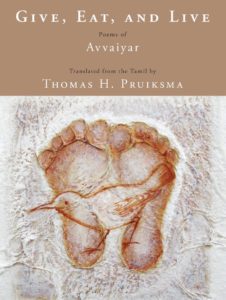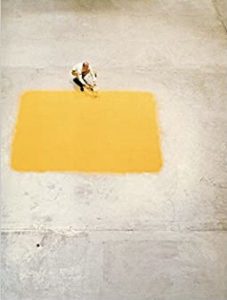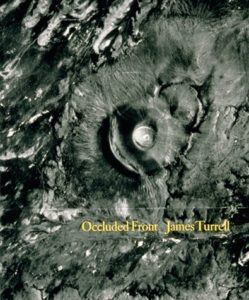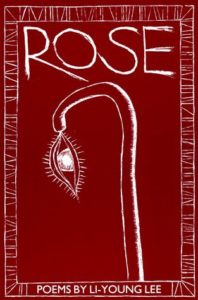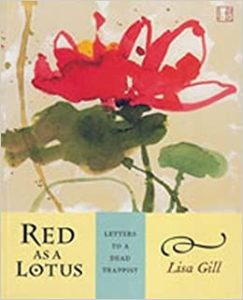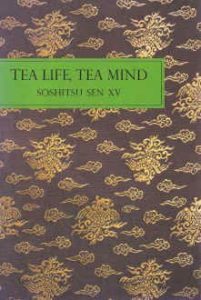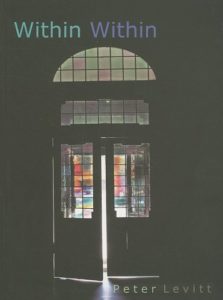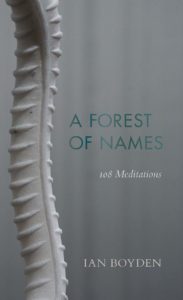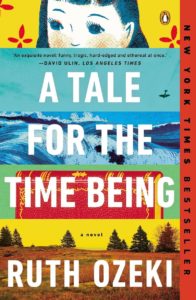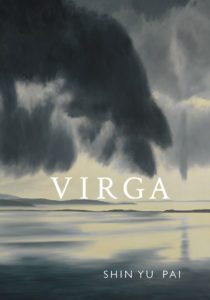Staying connected with a sense of the numinous has been one of the few things that’s gotten me through the last sixteen months of pandemic, while working from home and supporting my seven-year-old son through online learning. Time has often felt less than spacious in the past year, and it’s been easy to indulge in fear and anxiety, given the rise in anti-Asian hate crimes and the dehumanization of Asians. As my sense of alienation has waxed and waned, I have felt overly conscious at times of my embodied racialized experiences of being an Asian American woman. But that’s not where I want my mind or spirit to spend most of their time.
As an antidote, I turn towards sacred literature from various wisdom traditions and contemporary expressions of the sacred to remember what human beings have in common and what connects us to one another. The sacred, to my own mind, has little to do with anything religious, but rather a connection to all beings, past and present, living and dead, and even sentient beings in their non-human forms.
In my new poetry collection Virga, I explore this spiritual terrain to remember the practice of presence, even while moving through grief and loss. Sometimes my poems are acts of devotion, and other times, they become renewal of a commitment to a certain way of wanting to be in the world. The following is a compilation of books that I turn to when poetry, which is also sacred, feels like it has abandoned me.
***
The First Free Women: Poems of the Early Buddhist Nuns translated by Matty Weingast
A dear friend gave me a copy of The First Free Women after my former meditation teacher suddenly died and I felt particularly adrift. Though some of the poems in this book were written as early as the sixth century BCE and derive from the Therigatha, the language of these devotional poems feels deeply contemporary in conveying the timeless spiritual yearning that women contend with as they push beyond their roles as mothers, wives, and daughters to claim their own experience. These voices echoed throughout my mind as I worked on Virga.
Give, Eat, and Live: Poems of Avvaiyar translated by Thomas Hitoshi Pruiksma
I grew up hearing Chinese classical poetry recited by my father, whenever he wanted to evoke Confucian virtue, or greater lessons. When I first heard Pruiksma recite these poems in their source language, I found them strangely familiar. Translated from ancient Tamil texts, the poems of Avvaiyar encompasses multiple poets and wise women whose works are curated together into a single volume by poet-translator Thomas Pruiksma. Offering poems of prayer and worship, the poetic verses in this collection speak of ethics, character, and how to live even in the face of loss. “Till going, give / —what is it to us?—give, eat, and live.” These poems are like the good friends that you turn to in times of needing spiritual counsel.
Wolfgang Laib: A Retrospective by Klaus Ottman
I first encountered Wolfgang Laib’s work at the Dallas Museum of Art, where I worked as a museum educator in the early 2000s. In our galleries, I learned firsthand about the artist’s process from Laib himself. The German installation artist builds sculptures out of natural materials including flower pollen, stone, rice, and fragrant beeswax. His large floor pieces echo the edges of Rothko paintings, while his pollen forms “the five mountains not to climb on” evoke the imagination and ephemerality. All of Laib’s artworks suggest repetition and ritual: in the sifting of pollen to shape a sculpture; in the daily pouring of milk on marble that brings a cold stone to life.
Occluded Front by James Turrell
Years after visiting a number of James Turrell’s installations in Pomona, Dallas, Northampton, Arkansas, and Seattle, I bought this catalog at a secondhand bookstore in North Texas. I wanted to know more about the ideas behind Turrell’s work, since each time I visited a skyspace, I’d gotten into the habit of write a poem to mark the occasion. Occluded Front was published in 1985 to accompany a MOCA Los Angeles exhibition. Spanning Turrell’s many ways of using the medium of light, the book includes examples of his ganzfeld skyspaces, indoor light installations, photography, and his most ambitious project, Roden Crater. Occluded Front explores Turrell’s interest in creating architectures and atmosphere to shape perception and allow a viewer to “see yourself see.”
Rose by Li-Young Lee
Published in 1986, Li-Young Lee’s first book of poems cemented his status as a new and vital voice in Asian American literature. Lee writes with tender complexity of his father, a man who served as private physician to Mao and was imprisoned in Indonesia for his political associations. Exiled to the United States, Lee’s father embraced Christianity and became a Presbyterian minister which had a formative influence on the poet. Lee’s poems are praise songs grounded in Chinese culture and the everyday intimacy of familial life replete with love.
Red as a Lotus: Letters to a Dead Trappist by Lisa Gill
Though Thomas Merton died two years before she was born, poet Lisa Gill addressed her extended series of epistolary poems to the Catholic monk in this book of lyric meditations. Reflecting on her experiences of living in the desert of New Mexico, Gill writes of poverty, kinship with nature, the female body, faith, and spiritual practice. Of Merton as muse, she writes, “Your books are rocks. Stone me.” This poetic collection invites the gaze inward, creating a space for communal solitude.
Tea Life, Tea Mind by Soshitsu Sen XV
When my former lover (now husband) moved to Japan to study with the Grand Tea Master at the Urasenke School, I acquired this book to better understand the journey he’d embarked on. Soshitsu Sen XV’s perennial classic on the Way of Tea puts the contemplative practice into a deeper social context. Where other tea-related texts have focused on aesthetics, tea instruments, and sweets, Sen’s book gets at the philosophy of chanoyu. Through examining the guiding principles of tea—harmony, respect, purity, and tranquility—Sen illuminates the capacity for chanoyu to promote greater peace in the world. Human relationships and the connection between host and guest are regarded as the ground for humility and a space where a letting go of status and ego become possible.
Within Within by Peter Levitt
I first heard these Zen-influenced poems read aloud at the 2009 Montreal Zen Poetry Festival by Levitt, who is an ordained lay teacher and a translator of Buddhist texts. Levitt’s poems are deeply grounded in sensing—watching an eagle prey upon a flock of ducks in early morning, the tenderness for a dead mother long gone. The poet goes “within within” to hold both sorrow and happiness alongside one another, knowing “There / is no escaping / the ten directions / or ten thousand things, even when you die.” Poetry has always been my preferred vehicle for conveying Buddhist dharma. In these quiet narrative poems, a reader opens up to deep presence.
A Forest of Names: 108 Meditations by Ian Boyden
Poet and translator Ian Boyden spent a year translating the names of hundreds of school children that were killed in the 2008 Sichuan earthquake when their government-built school collapsed on them. In response to the Chinese government’s attempt to suppress the identities of the dead, artist Ai Weiwei gathered and published the names of 5,196 children that were killed in the disaster, compiling their names, age, gender, date of birth, and which school they attended. Moved by Ai Wei Wei’s activism, Boyden engaged in his own act of memorialization, through translating the poetic character of the names of the deceased, paired with elegiac verses. Forest of Names features 108 poems, a number that symbolizes the wholeness of our existence and the infinity of human experience within the Buddhist cosmos.
A Tale for the Time Being by Ruth Ozeki
At the end of every year, I undertake a marathon push of reading to get through books that I meant to read all year long. Ozeki’s book closed out my 2020. The book centers around Nao, a Japanese teenage girl, her Buddhist grandmother, and a Japanese American novelist named Ruth who discovers Nao’s journal when it washes up on Canadian shores following the tsunami of 2011. Nao’s diaristic musings put Ruth in the role of reader, paralleling the experience of a reader encountering Ozeki’s A Tale for the Time Being. Built upon the relationship of trust between writer and reader, Ozeki’s novel highlights the human desire for interconnected across time, space, and history.
And to close out this wonderful list, we just had to include Shin Yu’s new poetry collection, Virga, out now from Empty Bowl Press! – Ed.
Virga by Shin Yu Pai
After decades of promoting the Chinese masters of poetry and Buddhist texts, Empty Bowl is honored to publish its first collection by a female Asian American author. Virga, Shin Yu Pai’s elegant eleventh collection of poems, is a crisp and intelligent response to recent and ancient history. In poems at once visionary and practical, Virga portrays Buddhist thought from lived experience, and demonstrates the everyday life of a poet who can see for herself in the “shafts of rain going sublime” the reality of being an Asian American woman in America today. This collection rediscovers who we are in an age when hate-crimes and terrorization destroy the lives of Asians and all people of color. Experiencing these poems, we witness Shin Yu Pai rise in and through the wearying atmosphere of the “dominant caste,” as historian Isabel Wilkerson calls white culture, to hold herself, her child, her community, in that sublime state that, within the Zen mind, arises “before touching the ground.”
